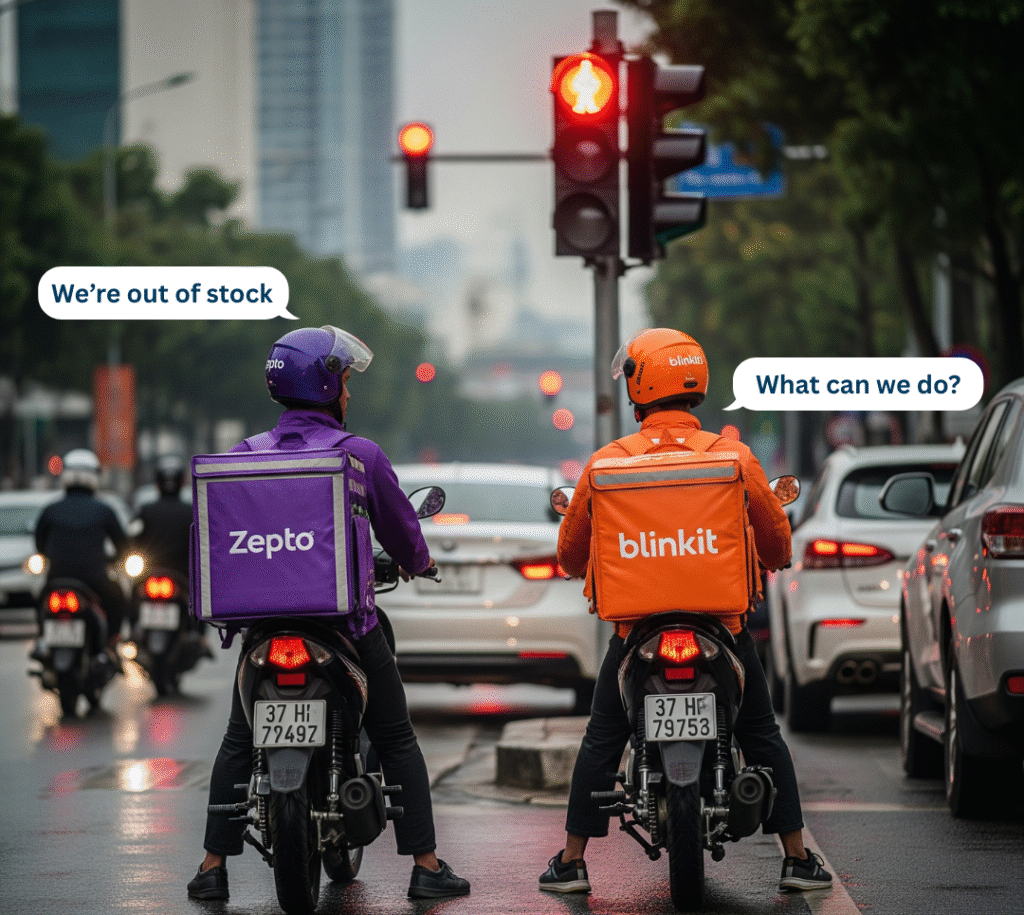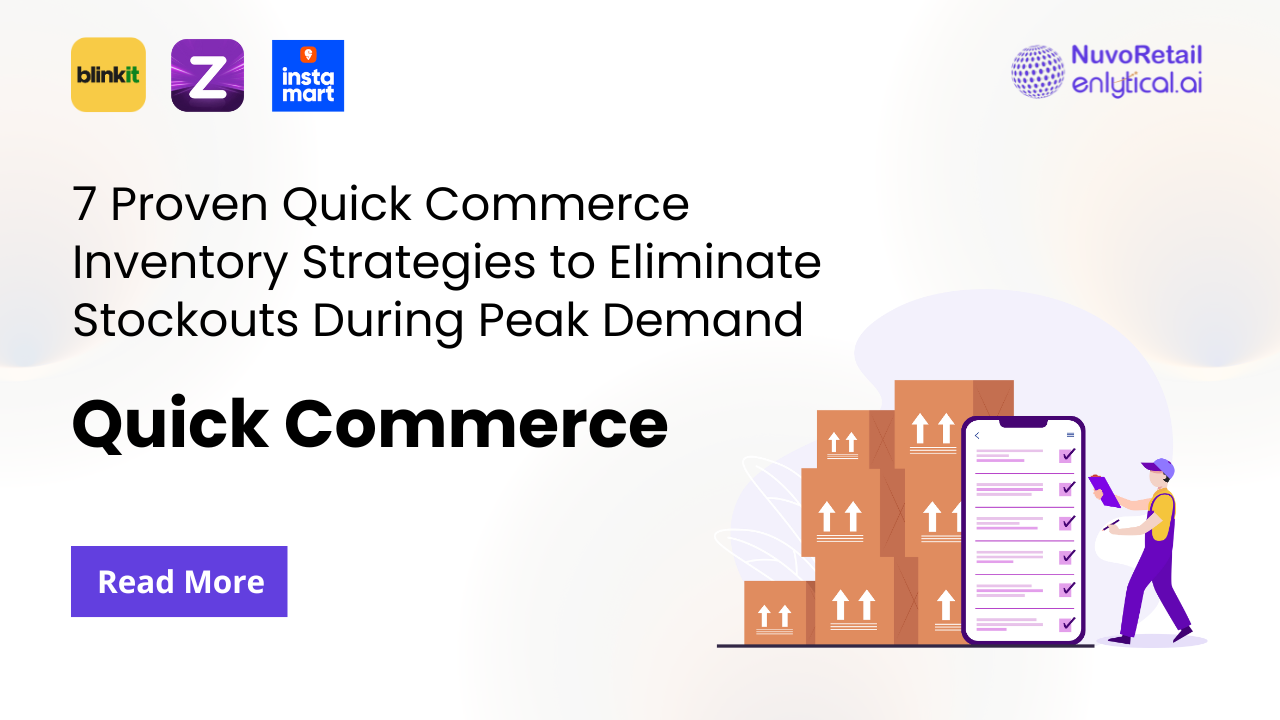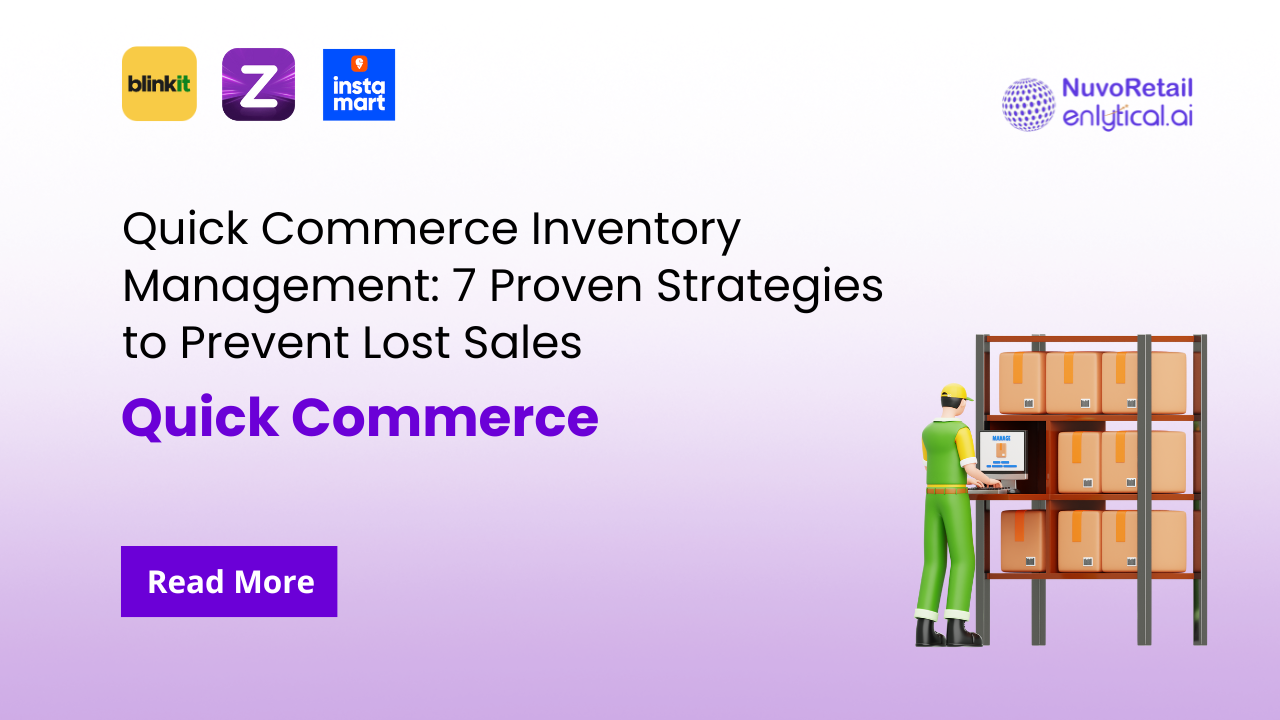Quick commerce inventory management has become the backbone of successful rapid delivery services in India’s booming market. With platforms like Blinkit, Zepto, and Swiggy Instamart promising deliveries within 10-30 minutes, maintaining optimal stock levels while avoiding costly stockouts during peak demand periods requires sophisticated planning and execution.
The explosive growth of quick commerce platforms has fundamentally changed consumer expectations around product availability and delivery speed. This shift has made quick commerce inventory strategies central to meeting consumer expectations. However, this convenience comes with significant operational challenges, particularly in inventory management where even minor miscalculations can lead to substantial revenue losses and customer dissatisfaction.
Managing inventory in such a fast-moving ecosystem requires specialized expertise. At NuvoRetail, we provide end-to-end quick commerce services that help brands streamline inventory, reduce stockouts, and maintain seamless delivery performance across Blinkit, Zepto, and Swiggy Instamart.
Table of Contents
- Understanding Quick Commerce Inventory Challenges
- Real-Time Demand Forecasting Techniques
- Strategic Safety Stock Management
- Dynamic Assortment Planning Strategies
- Technology-Driven Inventory Automation
- Peak Demand Preparation Methods
- Cross-Platform Inventory Optimization
- Performance Monitoring and Analytics
Understanding Quick Commerce Inventory Challenges
Quick commerce companies face unique inventory challenges that traditional e-commerce platforms don’t encounter. The promise of rapid delivery within minutes creates an environment where being out of stock isn’t just inconvenient—it’s business-critical.
The primary challenge lies in balancing inventory levels across multiple dark stores while maintaining service quality. Poorly managed quick commerce inventory often leads to frequent stockouts and dissatisfied customers. When a customer orders through the Blinkit app or Instamart app, they expect immediate availability. Any stockout situation directly impacts customer retention and platform reputation.
Quick commerce platforms must manage inventory across hundreds of micro-fulfillment centers, each serving specific geographic areas. This distributed model requires sophisticated stock level management to prevent both stockouts and excess inventory accumulation.

Key challenges include:
- Extremely short delivery windows leaving no buffer time
- High customer expectations for product availability
- Limited storage space in dark stores
- Rapid demand fluctuations throughout the day
- Complex supply chain coordination requirements
Real-Time Demand Forecasting Techniques
Effective quick commerce inventory optimization starts with accurate demand forecasting. Unlike traditional retail, q commerce requires minute-by-minute demand prediction to maintain optimal inventory levels.
To tackle these challenges, many leading brands partner with agencies like NuvoRetail, whose quick commerce marketing solutions leverage advanced analytics to anticipate demand shifts and ensure real-time stock visibility.
Machine learning algorithms analyze historical purchase patterns, seasonal trends, weather data, and local events to predict demand spikes. Supplymint highlights that incorporating velocity tracking and promotional calendars into demand forecasting helps quick commerce players strike the right balance between stockouts and overstocking.
Zepto’s success largely stems from its sophisticated forecasting system that anticipates demand changes hours before they occur.
Advanced forecasting considers multiple variables:
- Time-of-day purchasing patterns
- Weather-influenced demand (ice cream during heat waves, umbrellas during rain)
- Local events and festivals
- Marketing campaign impacts
- Competitor pricing and availability
Successful quick commerce inventory planning integrates external data sources including traffic patterns, local events, and even social media sentiment to enhance prediction accuracy. This comprehensive approach helps prevent both stockouts and overstock situations.
Strategic Safety Stock Management
Safety stock calculation in quick commerce inventory differs significantly from traditional retail due to the compressed delivery timeframes. Quick ecommerce platforms must maintain higher safety stock percentages to account for demand volatility and supply chain uncertainties.
The optimal safety stock level varies by product category, demand predictability, and supplier reliability. Fast-moving consumer goods require different safety stock strategies compared to seasonal or promotional items.
Salesforce emphasizes that inventory optimization goes beyond management—it requires proactive planning, automation, and real-time data visibility to maintain stock levels without tying up excessive capital.
Safety stock considerations for rapid delivery services:
- Lead time variability from suppliers
- Demand uncertainty during peak periods
- Service level targets
- Storage space constraints in dark stores
- Capital investment requirements
Zepto online has implemented dynamic safety stock models that adjust automatically based on real-time demand patterns and supplier performance metrics. This adaptive approach ensures optimal inventory levels without excessive capital tie-up.
For example, essential items like milk, bread, and vegetables require higher safety stock levels due to consistent demand, while niche products can operate with leaner safety stock to optimize warehouse space utilization.
Dynamic Assortment Planning Strategies
Assortment planning for quick commerce inventory requires continuous optimization based on local preferences, seasonal trends, and space constraints. Each dark store location must carefully curate its product mix to maximize sales while minimizing stockout risks.
Successful assortment strategy involves analyzing customer purchase behavior at the hyperlocal level. Products that perform well in one area might not have the same demand in another location just kilometers away.
Quick commerce platforms use A/B testing to optimize product assortments continuously. By testing different product combinations and measuring customer satisfaction and revenue metrics, platforms can refine their inventory mix for maximum efficiency.
Key assortment planning elements:
- Local demographic analysis
- Purchase frequency patterns
- Cross-selling opportunities
- Seasonal demand variations
- Competitor assortment analysis
Swiggy Instamart exemplifies effective assortment planning by maintaining different product mixes across various city zones while ensuring core essentials remain consistently available across all locations.
The assortment strategy must also account for storage limitations in dark stores, prioritizing products with optimal profit margins and turnover rates while maintaining customer satisfaction through essential item availability.
Technology-Driven Inventory Automation
Modern quick commerce companies leverage advanced technology solutions to automate quick commerce inventory management processes and reduce human error. Automated systems enable real-time inventory tracking, automatic reordering, and predictive stock management.
Internet of Things (IoT) sensors monitor inventory levels continuously, triggering automatic alerts when stock levels approach predetermined thresholds. This technology integration ensures rapid response to potential stockout situations before they impact customer experience.
Artificial intelligence algorithms analyze multiple data streams simultaneously, including sales velocity, supplier lead times, and demand forecasts, to make intelligent reordering decisions without human intervention.
Technology automation features:
- Real-time inventory tracking systems
- Automated purchase order generation
- Dynamic pricing based on inventory levels
- Predictive analytics for demand planning
- Integration with supplier systems for seamless replenishment
The Blinkit app utilizes sophisticated inventory management software that coordinates across multiple dark stores to optimize stock allocation based on real-time demand patterns and predicted customer behavior.
These automated systems also enable better supplier relationship management by providing accurate demand forecasts and enabling collaborative planning initiatives that benefit both the quick commerce platform and its suppliers.
Peak Demand Preparation Methods
Peak demand periods—including festivals, weather events, and promotional campaigns—require specialized inventory preparation strategies. Quick commerce platforms must anticipate these periods and adjust quick commerce inventory levels accordingly to prevent widespread stockouts.
According to Log-hub, building strong supplier relationships and optimizing safety stock are critical for managing peak demand, helping quick commerce platforms build a more resilient supply chain.
Historical data analysis reveals patterns around peak demand events, enabling platforms to prepare inventory buffers well in advance. However, the challenge lies in balancing increased inventory investment against the risk of excess stock post-peak period.
Effective peak demand preparation involves cross-functional coordination between marketing, operations, and supply chain teams. Marketing campaigns must align with inventory availability to prevent promoting products that may face stockout situations.
Peak demand preparation strategies:
- Historical demand pattern analysis
- Increased safety stock for high-demand products
- Supplier capacity planning and agreements
- Marketing campaign coordination
- Emergency supplier activation protocols
During major festivals like Diwali or Holi, quick commerce platforms often see 300-400% increases in demand for specific product categories. Zepto’s approach involves creating dedicated festival inventory plans that account for both expected demand increases and potential supply chain disruptions.
The preparation also includes scenario planning for different demand levels, ensuring the platform can respond effectively whether actual demand exceeds, meets, or falls short of predictions.
Cross-Platform Inventory Optimization
Many retailers operate across multiple quick commerce platforms simultaneously, requiring sophisticated quick commerce inventory allocation strategies to prevent stockouts across all channels while optimizing overall profitability.
Cross-platform inventory optimization involves real-time inventory sharing and allocation algorithms that distribute available stock across different platforms based on demand predictions and profitability metrics.
This approach requires integration between various quick commerce marketing systems and inventory management platforms to ensure accurate, real-time stock visibility across all channels.
Cross-platform optimization considerations:
- Platform-specific demand patterns
- Commission and fee structures
- Customer loyalty and retention metrics
- Promotional calendar alignment
- Inventory allocation priority rules
Advanced retailers use unified inventory management systems that provide single-source-of-truth inventory data across all platforms, enabling dynamic allocation based on real-time demand and profitability analysis.
The optimization extends to supplier relationships, where retailers negotiate terms that support multi-platform operations while maintaining service level commitments across all channels.
Performance Monitoring and Analytics
Continuous monitoring and analytics are essential for maintaining optimal quick commerce inventory performance. Key performance indicators (KPIs) must be tracked in real-time to identify potential issues before they impact customer experience.
Essential metrics include stockout rates, inventory turnover, demand forecast accuracy, and supplier performance indicators. These metrics provide insights into inventory management effectiveness and highlight areas for improvement.
ChannelEngine stresses that closely monitoring metrics is crucial for avoiding stockouts, since they act as early warning signals for potential supply gaps.
Advanced analytics platforms provide dashboard views of inventory performance across multiple locations, enabling quick identification of trends and anomalies that require immediate attention.
Critical inventory KPIs:
- Stockout frequency by product and location
- Inventory turnover rates
- Demand forecast accuracy percentages
- Supplier on-time delivery performance
- Customer satisfaction scores related to product availability
Regular performance reviews enable continuous optimization of inventory strategies and help identify seasonal patterns or emerging trends that require strategy adjustments.
Conclusion
Quick commerce inventory optimization requires a multifaceted approach to quick commerce inventory that combines advanced technology, data analytics, and strategic planning. Partner with NuvoRetail quick commerce experts to future-proof your operations, eliminate costly stockouts, and maximize ROI in this fast-paced market.
The seven proven strategies outlined from real-time demand forecasting to cross-platform optimization provide a comprehensive framework for preventing stockouts during peak demand periods.
Success in quick commerce inventory management ultimately depends on continuous adaptation and improvement. As platforms like Blinkit, Zepto, and Swiggy Instamart continue evolving their capabilities, retailers must stay ahead of the curve by implementing sophisticated inventory management practices that balance customer satisfaction with operational efficiency.
The future of quick commerce lies in predictive, automated systems that can anticipate and respond to demand changes in real-time while maintaining optimal inventory levels across all locations and platforms.
Optimize Your Inventory Before the Next Demand Surge
Ready to optimize your quick commerce inventory management? Start by implementing demand forecasting tools and establishing safety stock protocols for your top-selling products. Share your inventory optimization experiences in the comments below.
At NuvoRetail, we help brands maximize ROI through our tailored quick commerce solutions. Contact us today to learn how we can support your Blinkit, Zepto, and Swiggy Instamart strategies.
What challenges are you facing with quick commerce inventory management in your quick commerce operations? Let’s discuss solutions in the comments section!




